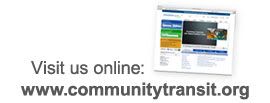Shawn shares his story on the benefits of being a Vanpool rider
Bringing You Home with Vanpool from
Community Transit on
Vimeo.
You've seen them, the
Community Transit vanpool vans, whizzing by you in the carpool lane. If you dread your commute each day, riding in a vanpool may be just the ticket for transforming your commute into one you actually enjoy. Meet Shawn, who joined his first vanpool ten years ago, relying on the service through graduate school and his professional life.
A vanpool is a group of 5-15 riders who commute to the same work place. Each vanpool van sets its own schedule and route. Fares are based on the size of the van and the daily mileage, and cover all gas, maintenance and insurance. Shawn's van seats 12 riders, though 15 riders take advantage of the service and rotate seats. By riding a van, not only are commuters saving money, they're saving space on the highway, which means saving the environment. Shawn says, "There are the obvious cost benefits, and avoiding the wear and tear on your own vehicle. And then there's the other benefit of doing something good for the environment, knowing that there's not 12 cars on the road and instead you're all combining into one."

Each day Shawn's round trip to and from work is about 50 miles and takes about 40 minutes. That's 40 minutes to carve out a little time in a busy life. How does Shawn spend his time? Reading, working, and, yes, napping. "Sometimes you get to take a nap. That's always a great thing, especially if you didn't get a good night's sleep. I have a little child and sometimes my sleep's not the best and you can catch up."
When you're not getting a little shut eye or catching up on work emails, you might be surprised at how commuting with coworkers helps you feel more connected to your community. "You get to meet a lot of people, people that you wouldn't normally have a conversation with. When I was going to school I found a lot of people that joined the van I then ran into in class. It helps make things feel a little bit smaller being in a big city like Seattle."
Shawn also enjoys the benefits of transit outside of work hours. "Occasionally I'll take the bus downtown. The price of parking has gotten pretty high. If there's a Mariners game it's anywhere from $30 - $40, and if you can take the bus you don't have to worry about that." Shawn and his wife also take their young child on bus outings, "When you don't have to worry about driving, you can all just be present with each other."
Let us make it easy for you to get to work and bring you home with Vanpool. Our Community Transit
Vanpool Program coordinators provide support for group formation, driver orientation, vehicle maintenance and rider recruitment. In other words, when you're ready to take advantage of our vanpool program, they'll work hard to make it happen.
If you could get out from behind the wheel on your commute, what would you do with your free time?


















